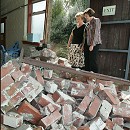Dear Mr Fassbender,
The recent 8.2 quake in Chile has inspired me to follow up my email from March 30, 2014 with some further suggestions on how to cost-effectively accelerate the seismic upgrading process of BC Schools.
I totally understand your hesitation due to the fact a project like this could get out of control on costs very easily. Also, since there’s no way to know when the project has to be done (i.e. when does a big earthquake next occur?) there’s a normal human tendency to defer.
I am a project manager and controlling the scope of the project is the key way to keep costs under control. There are three types of projects.
1. Something new that will generate new revenue (e.g. LNG plants)
2. Something new that will reduce costs (e.g. replacing aging computer systems)
3. Regulatory or Safety projects (This is how I classify seismic upgrading)
Type 3 projects are the least fun because there’s no real ROI. In the case of replacing schools you might see some reduction in maintenance and heating costs over time, but it’s not a big win.
The other problem is that you are faced with is the adding on of extras. For example, rescuing heritage buildings, adding capacity in tight neighbourhoods or adding community centre types of facilities are but three potential areas for scope creep.
But, here’s your solution. Find the money to replace the buildings that are unsafe (unless remediation of a building is cheaper). Tell each district that is your plan. For all schools that can be replaced, without expanding capacity beyond about 15%, and without special requirements, move them to the top of the list in order of danger. Start these replacements right away. For schools with “special requirements” you can advise districts that they have to justify and fund the extras.
Wouldn’t this meet the need for speed on this project and keep the scope from expanding?
I look forward to your response.

Leave a Reply